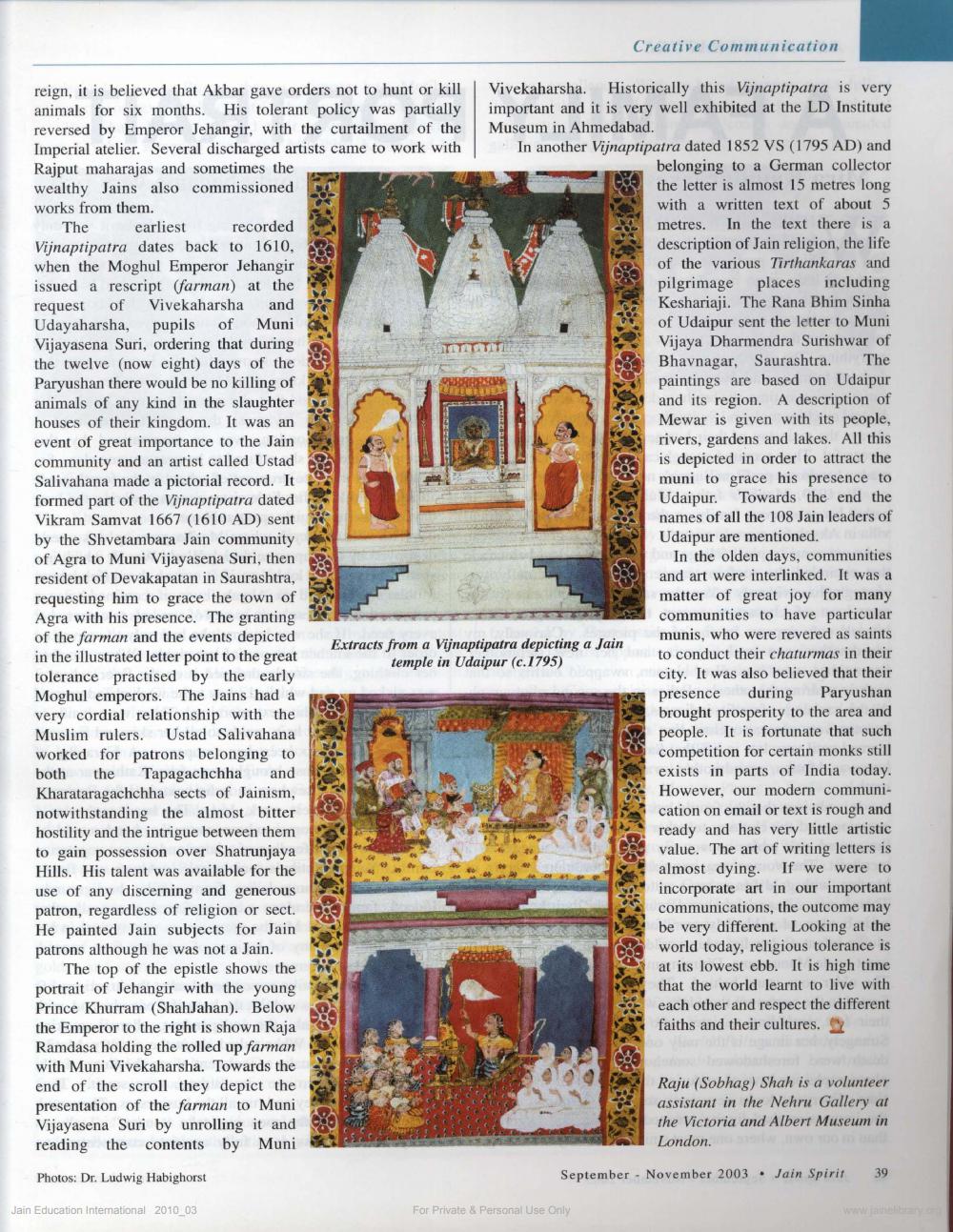________________
Creative Communication
reign, it is believed that Akbar gave orders not to hunt or kill Vivekaharsha. Historically this Vijnaptipatra is very animals for six months. His tolerant policy was partially important and it is very well exhibited at the LD Institute reversed by Emperor Jehangir, with the curtailment of the Museum in Ahmedabad. Imperial atelier. Several discharged artists came to work with In another Vijnaptipatra dated 1852 VS (1795 AD) and Rajput maharajas and sometimes the
belonging to a German collector wealthy Jains also commissioned
the letter is almost 15 metres long works from them.
with a written text of about 5 The earliest recorded
metres. In the text there is a Vijnaptipatra dates back to 1610,
description of Jain religion, the life when the Moghul Emperor Jehangir
of the various Tirthankaras and issued a rescript (farman) at the
pilgrimage places including request of Vivekaharsha and
Keshariaji. The Rana Bhim Sinha Udayaharsha, pupils of Muni
of Udaipur sent the letter to Muni Vijayasena Suri, ordering that during
Vijaya Dharmendra Surishwar of the twelve (now eight) days of the
Bhavnagar, Saurashtra. The Paryushan there would be no killing of
paintings are based on Udaipur animals of any kind in the slaughter
and its region. A description of houses of their kingdom. It was an
Mewar is given with its people, event of great importance to the Jain
rivers, gardens and lakes. All this community and an artist called Ustad
is depicted in order to attract the Salivahana made a pictorial record. It
muni to grace his presence to formed part of the Vijnaptipatra dated
Udaipur. Towards the end the Vikram Samvat 1667 (1610 AD) sent
names of all the 108 Jain leaders of by the Shvetambara Jain community
Udaipur are mentioned. of Agra to Muni Vijayasena Suri, then
In the olden days, communities resident of Devakapatan in Saurashtra,
and art were interlinked. It was a requesting him to grace the town of
matter of great joy for many Agra with his presence. The granting
communities to have particular of the farman and the events depicted Extracts from a Vijnaptipatra depicting a Jain
munis, who were revered as saints in the illustrated letter point to the great
temple in Udaipur (c.1795)
to conduct their chaturmas in their tolerance practised by the early
city. It was also believed that their Moghul emperors. The Jains had a
presence during Paryushan very cordial relationship with the
brought prosperity to the area and Muslim rulers. Ustad Salivahana
people. It is fortunate that such worked for patrons belonging to
competition for certain monks still both the Tapagachchha and
exists in parts of India today. Kharataragachchha sects of Jainism,
However, our modern communinotwithstanding the almost bitter
cation on email or text is rough and hostility and the intrigue between them
ready and has very little artistic to gain possession over Shatrunjaya
value. The art of writing letters is Hills. His talent was available for the
almost dying. If we were to use of any discerning and generous
incorporate art in our important patron, regardless of religion or sect.
communications, the outcome may He painted Jain subjects for Jain
be very different. Looking at the patrons although he was not a Jain.
world today, religious tolerance is The top of the epistle shows the
at its lowest ebb. It is high time portrait of Jehangir with the young
that the world learnt to live with Prince Khurram (ShahJahan). Below
each other and respect the different the Emperor to the right is shown Raja
faiths and their cultures. Ramdasa holding the rolled up farman with Muni Vivekaharsha. Towards the end of the scroll they depict the
Raju (Sobhag) Shah is a volunteer presentation of the farman to Muni
assistant in the Nehru Gallery at Vijayasena Suri by unrolling it and
the Victoria and Albert Museum in reading the contents by Muni
London.
Photos: Dr. Ludwig Habighorst
September - November 2003 . Jain Spirit
39
Jain Education International 2010_03
For Private & Personal Use Only




